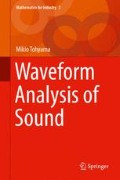Abstract
The temporal nature of a sequence is observed in narrow-band envelopes or frame-wise spectra. The envelopes represent the temporal changes in macroscopic structures, whereas the frame-wise spectral properties can be interpreted as related to the time-dependent fine structure of a sequence. The local behavior of phase spectral records or group delay is crucial in the construction of the envelopes. Inspired by the methods used for group delay, triangular window functions are introduced to divide a sequence into short frames. Consequently, the differential (averaging) properties of the spectral functions are formulated in terms of triangular with a positive (negative) slope windowing. Moreover, the short-term auto-correlations are obtained keeping its non-negative Fourier transform. Taking the causal part of the short-term autocorrelation sequence yields the complex power spectral function, the magnitude of which gives the temporal change in the power spectral envelope.
The original version of this chapter was revised.
An erratum to this chapter can be found at DOI 10.1007/978-4-431-54424-1_10
Access this chapter
Tax calculation will be finalised at checkout
Purchases are for personal use only
References
R. Meddis, M.J. Hewitt, Virtual pitch and phase sensitivity of a computer model of the auditory periphery. I: Pitch identification. J. Acoust. Soc. Am. 89(6), 2866–2882 (1991)
M.R. Schroeder, Computer Speech (Springer, 1999)
M.R. Schroeder, Improved quasi-stereophony and colorless artificial reverberation. J. Acoust. Soc. Am. 33, 1061–1064 (1961)
M.R. Schroeder, H.W. Strube, Flat-spectrum speech. J. Acoust. Soc. Am. 79(5), 1580–1583 (1986)
A.V. Oppenheim, J.S. Lim, The importance of phase in signals. Proc. IEEE 69(5), 529–541 (1981)
M. Kazama, S. Gotoh, M. Tohyama, T. Houtgast, On the significance of phase in the short term Fourier spectrum for speech intelligibility. J. Acoust. Soc. Am. 127(3), 1432–1439 (2010)
M. Tohyama, Sound and Signals (Springer, 2011)
W.A. Yost, R. Patterson, The role of envelope in processing iterated ripped noise. J. Acoust. Soc. Am. 104(4), 2349–2361 (1998)
T. Houtgast, H.J.M. Steeneken, R. Plomp, A review of the MTF concept in room acoustics and its use for estimating speech intelligibility in auditoria. J. Acoust. Soc. Am. 77(3), 1069–1077 (1985)
M.R. Schroeder, Modulation transfer functions: definition and measurement. Acustica 49(3), 179–182 (1981)
G. Strang, T. Naguyen, Wavelets and Filter Banks (Wellesley Cambridge Press, 1997)
B.C.J. Moore, An Introduction to the Psychology of Hearing, 4th edn (Academic Press, 1997)
R. Meddis, M.J. Hewitt, Virtual pitch and phase sensitivity of a computer model of the auditory periphery. II: Phase sensitivity. J. Acoust. Soc. Am. 89(6), 2883–2894 (1991)
R. Meddis, L. O’Mard, A unitary model of pitch perception. J. Acoust. Soc. Am. 102(3), 1811–1820 (1997)
M.R. Schroeder, Models of hearing. Proc. IEEE 63(9), 1332–1350 (1975)
R.D. Patterson, K. Robinson, J. Holdsworth, D. McKeown, C. Zhang, M. Allerhand, Complex sounds and auditory images. Audit. Physiol. Percep. 83, 429–446 (Pergamon Press, 1992)
R. Drullman, Temporal envelope and fine structure cues for speech intelligibility. J. Acoust. Soc. Am. 97(1), 585–592 (1995)
W.M. Hartmann, Signals, Sound, and Sensation (Springer, 1997)
R.H. Lyon, Machinery Noise and Diagnostics (Butterworth, 2000)
M. Tohyama, T. Koike, Fundamentals of Acoustic Signal Processing (Academic Press, 1998)
A.V. Oppenheim, R.W. Shafer, Digital Signal Processing (Prentice-Hall, 1975)
Y. Takahashi, M. Tohyama, Y. Yamasaki, Cumulative spectral analysis for transient decaying signals in a transmission system including a feedback loop. J. Audio Eng. Soc. 54(7/8), 620–629 (2006)
Y. Ando, Auditory and Visual Sensation (Springer, 2009)
Author information
Authors and Affiliations
Rights and permissions
Copyright information
© 2015 Springer Japan
About this chapter
Cite this chapter
Tohyama, M. (2015). Temporal and Spectral Characteristics of Discrete Sequence. In: Waveform Analysis of Sound. Mathematics for Industry, vol 3. Springer, Tokyo. https://doi.org/10.1007/978-4-431-54424-1_3
Download citation
DOI: https://doi.org/10.1007/978-4-431-54424-1_3
Published:
Publisher Name: Springer, Tokyo
Print ISBN: 978-4-431-54423-4
Online ISBN: 978-4-431-54424-1
eBook Packages: EngineeringEngineering (R0)

